Class Aves Family Estrildidae Scientific name Taeniopygia guttata Clutch size 2 – 7 Length 10 – 11 cm | Phylum Chordata Order Passeriformes Genus Taeniopygia Lifespan 2 – 5 years (In the wild) Mass 12 g Rank Species | |
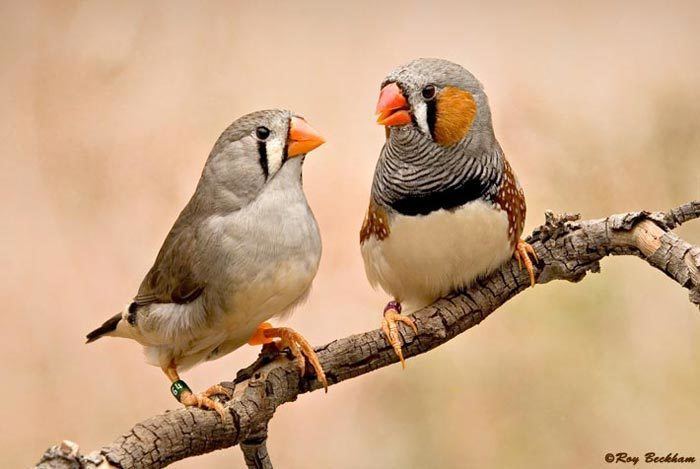 | ||
Similar Bird, Gouldian finch, Finch, Society finch, Domestic canary | ||
Zebra finch singing its heart out
The zebra finch (Taeniopygia guttata [formerly Poephila guttata]), is the most common estrildid finch of Central Australia and ranges over most of the continent, avoiding only the cool moist south and some areas of the tropical far north. It can also be found natively in Indonesia and East Timor. The bird has been introduced to Puerto Rico and Portugal.
Contents
- Zebra finch singing its heart out
- My tamed zebra finches
- Habitat
- Life cycle
- Subspecies
- Song and other vocalizations
- Diet
- Breeding
- Inbreeding
- References
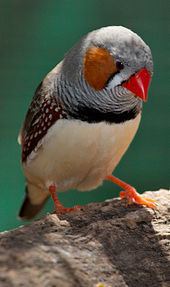
My tamed zebra finches
Habitat
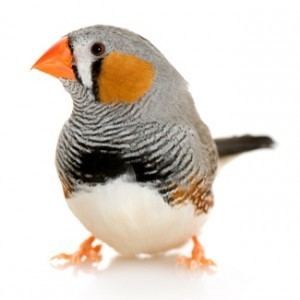
Zebra finches inhabit a wide range of grasslands and forests, usually close to water. They are typically found in open steppes with scattered bushes and trees, but have adapted to human disturbances, taking advantage of human-made watering holes and large patches of deforested land. Zebra finches — including many human-bred variants to the species — are widely kept by genetic researchers, breeding hobbyists and pet owners.
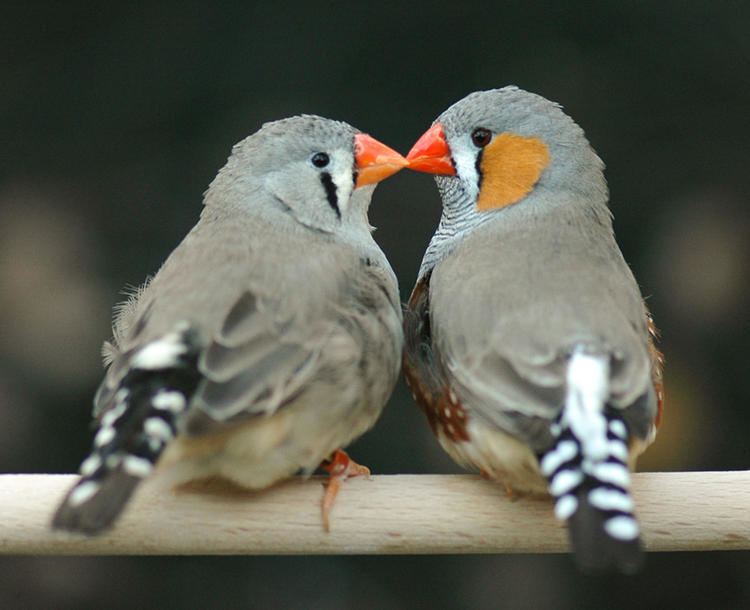
The zebra finch breeds after substantial rains in its native habitat, which can occur at any time of the year. Birds in captivity are ready to breed year-round. Wild birds are adaptable and varied in their nesting habits, with nests being found in cavities, scrub, low trees, bushes, on the ground, in termite hills, rabbit burrows, nests of other birds, and in the cracks, crevices, and ledges of human structures. Outside of the breeding time, brood nests are constructed for sleeping in.
Zebra finches are distributed over much of Australia and the Lesser Sunda Islands (Nusa Tenggara), which are north-west of Australia.
Life cycle
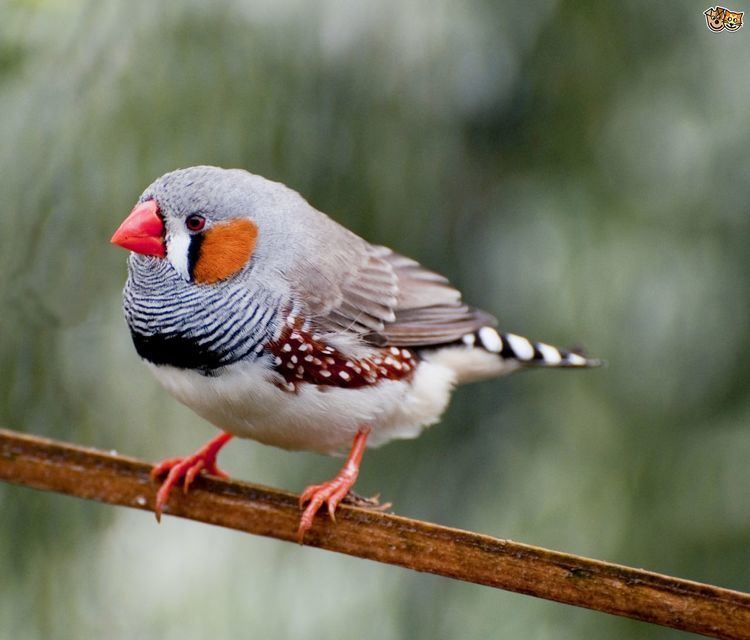
The life expectancy of a zebra finch is highly variable because of genetic and environmental factors. The zebra finch may reach up to five years in its natural environment. If they are kept caged, they normally live for 5 to 9 years but may live as long as 12 years, with an exceptional case of 14.5 years reported for a caged specimen. The greatest threats to zebra finch survival are predation by cats and loss of natural food.
Subspecies
The two subspecies are:
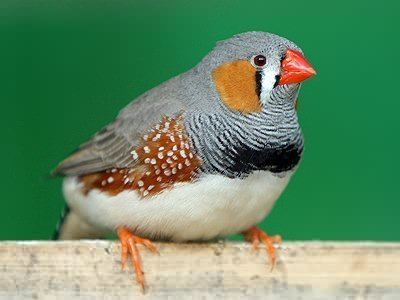
The Australian race is sometimes split as chestnut-eared finch (Gould, 1837), Taeniopygia castanotis.
The morphological differences between the subspecies include differences in size. T. g. guttata is smaller than T. g. castanotis. In addition, the T.g. guttata males do not have the fine barring found on the throat and upper breast of T.g. castanotis, as well as having small breast bands.
Song and other vocalizations
Zebra finches are loud and boisterous singers. Their calls can be a loud beep, meep, oi! or a-ha!. Their song is a few small beeps, leading up to a rhythmic song of varying complexity in males. Each male's song is different, although birds of the same bloodline will exhibit similarities, and all finches will overlay their own uniqueness onto a common rhythmic framework. Sons generally learn the song of their fathers with little variation. There is a critical sensitive period during which juvenile males learn their songs by imitating a mature, male tutor. Subsong (early vocalizations) evolve into 'plastic song'. This plastic song is variable between renditions but begins to incorporate some recognizable elements of tutor songs. A study conducted by Nottebohm et al., has shown that birds were able to successfully imitate their tutor’s song after relatively short exposure (40 playbacks of the motifs lasting 30 seconds total) over the duration of their sensitive learning period. These birds eventually form a “template” of what their correct song should sound like. They rely on auditory feedback for both song learning and practice as juveniles and song maintenance as adults. Adult birds maintain their songs by correcting any deviations from their target song template. During adulthood, by around 90 days, the bird’s song goes through a crystallization phase where their song template is stable and it no longer changes.
Male zebra finches begin to sing at puberty, while females lack a singing ability. This is due to a developmental difference, where in the embryo, the male zebra finch produces testosterone, which is transformed into estradiol in the brain, which in turn leads to the development of the nervous system for a song system. Activation of song behavior later depends on androgens. Their songs begin as a few disjointed sounds, but as they experiment, they match what they sing to the memory of their tutor's song, and they rapidly mature into full-fledged songs. During these formative times, they will incorporate sounds from their surroundings into their songs, also using the songs of other nearby males for inspiration.
Male finches use their songs, in part, as a mating call. The mating act is usually accompanied by a high-pitched whining sound. They will also exhibit a hissing sound when protecting their territories.
Because zebra finch males learn their songs from their surroundings, they are often used as avian model organisms to investigate the neural bases of learning, memory, and sensorimotor integration. For example, studies have investigated the role of FoxP2 in song learning and have found that in young finches both knockdown and overexpression of FoxP2 in the striatal song control nucleus, Are X, prevents accurate song learning and tutor imitation. These studies also have implications for human speech. Individuals heterozygous for a point mutation in FOXP2 manifest a speech disorder. Because of similar expression patterns between humans and songbirds, the zebra finch is used as a model to study FoxP2 expression and function. The zebra finch genome was the second bird genome to be sequenced, in 2008, after that of the chicken. Their popularity as model organisms is also related to their prolific breeding, an adaptation to their usually dry environment. This ability also makes them popular as pet songbirds.
Diet
Zebra finches, like most estrildid finches, are primarily seed-eating birds, as their beaks are adapted for dehusking small seeds. They prefer millet, but will consume many other kinds of seeds, as well. While they prefer seeds, captives will also eat egg food. They also readily consume fresh foods, such as small bits of chopped lettuce, and apples. They are particularly fond of spray millet, and one or two of these small birds will eat a spray millet stalk within a few days. Zebra finches are messy and voracious eaters, typically dropping seeds everywhere. This behaviour spreads seed around, aiding in plant reproduction. The availability of water is important to this bird's survival, therefore the zebra finch will drink often when water is available and enjoys taking bird baths in a small, shallow bowl. A typical zebra finch may be plump, because it eats quite often throughout the day, but an overweight bird needs more exercise, not less food. Finches should always have access to fresh food and water.
Breeding
In the zebra finch, sudden bursts of gathering behaviours signal that a pair is ready to nest. The pair will pull strings or plant leaves they can reach, and if no materials are available to gather, they will use feathers and bits of seed husks. Alfalfa or timothy hay is an acceptable nesting material, as it is closest to what is readily available in the wild. Any item they can use to build a nest will be deposited in a corner of the cage floor, or in their food dish. When these behaviours are noticed, a mating pair should be provided with a sturdy wicker nest about the size of a large apple or orange. This nest should always be placed in the highest possible corner of the cage, opposite the food dish, but near the normal night perch. Nesting finches will abandon a perch if it is across the cage, with the male showing he prefers to sit atop the nest while the female lays. During the nest building, however, both will spend the night cuddling inside the nest.
When they accept the nest shell and begin using it each night, they should be provided with an ample supply of very soft bits of short string and leaves. They prefer items only a couple of inches long and will use nearly any type and colour of soft material; longer bits of string or nesting material can tangle around the finches or nestlings and cause distress that will lead to strangulation or even death. The nest shell will be packed with everything they can reach for at least a week before laying begins.
The number of eggs ranges from two to seven eggs per clutch, with five being the most common number. In captivity, some birds lay larger clutches.
Males and females are very similar in size, but are easily distinguished from one another, as the males usually have bright orange cheek feathers, red beaks (as opposed to the orange beaks of females), and generally more striking black and white patterns. The beak is sometimes the only way to tell the sex of a zebra finch, as sometimes the orange cheek colouring is faded or non-existent. However, the orange cheeks are a stubborn indication that a young zebra finch is indeed a male and the cheeks begin to appear when the young are about two months old. Young zebra finches will also have black beaks, with the colouring coming in at puberty, though it begins changing at age one month.
The chicks will hatch according to the laying time of each egg. It is common to have one or two eggs remaining unhatched as the parents begin the task of feeding the nestlings. Though it is preferable to leave nests alone after the egg-laying begins, once hatching begins, a breeder might find it useful to make daily checks into the nest to correct problems early, such as larger chicks sitting on and smothering smaller ones, thus increasing the number of chicks that eventually fledge. The time from laying until a fledgling adventures outside will vary with each clutch, but generally good eggs will hatch within 14 to 16 days of laying and young will begin to venture out within about three or four weeks of hatching, and will look full-grown in about three months. Breeding age is six or more months. Zebra finches are usually excellent parents and will readily take turns sitting on the nest and bringing food to the young.
While the female is laying, only her mate will be allowed in the nest. Allowing the pair to start a new family while the first clutch is still in the cage will overly stress all the birds in the family. The male of the breeding pair will not allow any other birds near the nest while eggs are being laid. It is advised that fully weaned birds from the previous clutch be removed and placed into a separate enclosure to prevent aggressive actions of the adult male who will likely try to beat up younger birds which are seen as competition for the female's attention.
Inbreeding
Inbreeding causes early death (inbreeding depression) in zebra finch. Embryo survival (that is, hatching success of fertile eggs) was significantly lower for sib-sib mating pairs than for unrelated pairs. Inbreeding depression mostly arises due to the expression of deleterious recessive alleles.
